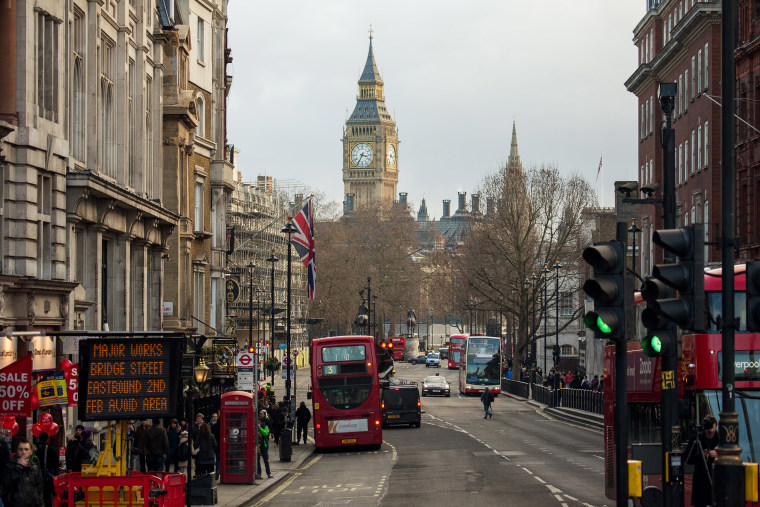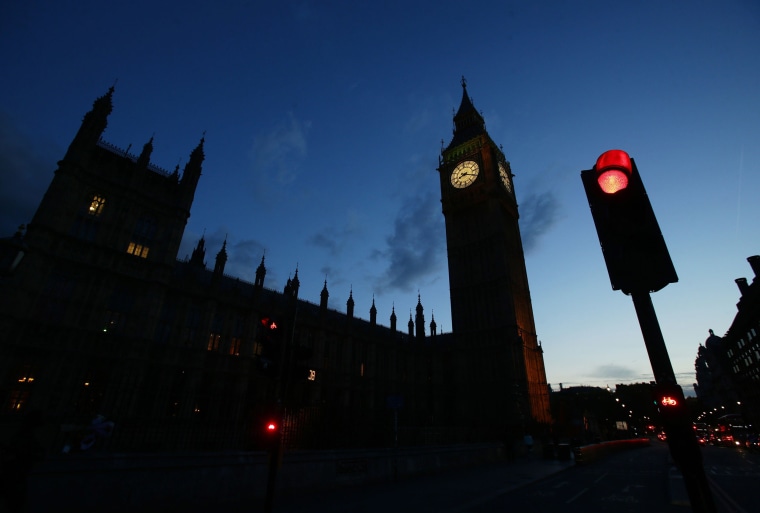LONDON — Traffic lights are such a ubiquitous feature of the modern city that no one thinks much about them until you're stuck in a line of cars, impatiently waiting for the light to turn green.
But there was a time when cities were signal-free and traffic was directed by police officers — or not at all. That changed 150 years ago on Monday when the world’s first traffic light was installed in London. Towering 20 feet above the street, the gas-powered signal was placed at the busy intersection outside the Houses of Parliament.

With more than 1,000 people dying each year on London's horse-and-buggy-clogged roads at the time, city leaders knew they had to do something, according to the Transport for London transit authority. Invented by railway engineer J.P. Knight, the traffic light did just that.
Given its inventor's occupation, it's not surprising that it resembled a railway signal and was equipped with both waving arms and gas-powered green and red lights for use at night. A police officer changed the lights manually, using switches.
Despite the British capital's attempt to improve safety, the introduction of this new technology wasn’t without controversy.
“The direct control of our movement — stop now, go now — sat uneasily in Victorian liberal society,” said David Rooney, a researcher at Royal Holloway, University of London, and the author of a book on this history of traffic congestion.
At the time, London arguably needed more traffic control than ever. Its population had exploded from around 3 million in 1861 to around 7 million by 1910.
However, the reign of the world’s first traffic light was extraordinarily short-lived. A gas leak caused a series of explosions, seriously injuring a policeman, after just a month in action.
The city had to wait nearly six decades for traffic lights to really take off in 1925, when signals with electric lights came to London from the U.S.
Today, there are nearly 9 million people living in the greater London area. It’s the world’s seventh most congested city, behind Los Angeles at No. 1 and New York at 3, according to transport analytics company Inrix’s global traffic scorecard.

Parliament Square is now one of the capital’s busiest areas. Tourists, civil servants and politicians cram the sidewalks, while cars and trucks stream over the bridge to South London.
At the intersection where the first traffic light stood, there are now 24 individual lights directing cars and pedestrians, overlooked by a statue of Winston Churchill.
They are among the more than 6,000 lights that control traffic in London, and while they control traffic, they've done little to stem its flow.
“Driving around here is murder," Clive Pearce, a black-cab driver, said as he dropped off passengers outside Westminster Abbey. "I started driving 42 years ago and traffic is now the worst I’ve seen. A journey that used to take me 20 minutes from west to east now takes an hour.”
Although the technology behind the lights has changed over the years — from gas to today’s LED lights — the way we control traffic has altered little since Queen Victoria sat on the throne.
“With such a complex and expensive infrastructure buried under our feet, it seems as if traffic lights are here to stay," Rooney said. "Because despite all efforts to solve the traffic problem, our cities will always be congested."

